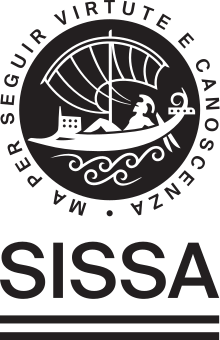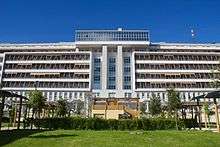International School for Advanced Studies
The Scuola Internazionale Superiore di Studi Avanzati (SISSA) is an international, state-supported, post-graduate-education and research institute, located in Trieste, Italy.
Scuola Internazionale Superiore di Studi Avanzati | |
 | |
| Motto | ... ma per seguir virtute e canoscenza (... to follow virtue and knowledge) |
|---|---|
| Type | State-supported Graduate Institute |
| Established | 1978 |
| Director | Prof. Stefano Ruffo |
Administrative staff | 88 |
| Location | , |
| Website | www |

SISSA is active in the fields of mathematics, physics, and neuroscience, offering both undergraduate and post-graduate courses. Each year, about 70 PhD students are admitted to SISSA based on their scientific qualifications. SISSA also runs master's programs in the same areas, in collaboration with both Italian and other European universities.
History
SISSA was founded in 1978, as a part of the reconstruction following the Friuli earthquake of 1976. Although the city of Trieste itself did not suffer any damage, physicist Paolo Budinich asked and obtained from the Italian government to include in the interventions the institution of a new, post-graduate teaching and research institute, modeled on the Scuola Normale Superiore di Pisa. The school became operative with a PhD course in theoretical physics, and Budinich himself was appointed as general director. In 1986, Budinich left his position to Daniele Amati, who at the time was at the head of the theoretical division at CERN. Under his leadership, SISSA expanded its teaching and research activity towards the field of neuroscience, and instituted a new interdisciplinary laboratory aiming at connecting humanities and scientific studies. From 2001 to 2004, the director was the Italian geneticist Edoardo Boncinelli, who fostered the development of the existing research areas. Other directors were appointed in the following years, which saw the strengthening of SISSA collaboration with other Italian and European universities in offering master's degree programs in the three areas of the School (mathematics, physics and neuroscience). The physicist Stefano Ruffo, the current director, was appointed in 2015. He signed a partnership with the International Centre for Genetic Engineering and Biotechnology to set up a new PhD program in Molecular Biology, with teaching activity organized by both institutions.
Organization
SISSA houses the following research groups:
- Astroparticle Physics[1]
- Astrophysics[2]
- Condensed Matter[3]
- Molecular and Statistical Biophysics[4]
- Statistical Physics[5]
- Theoretical Particle Physics[6]
- Cognitive Neuroscience[7]
- Neurobiology[8]
- Molecular Biology[9]
- Applied Mathematics
- Geometry[10]
- Mathematical Analysis[11]
- Mathematical Physics[12]
In addition, there is the Interdisciplinary Laboratory for Natural and Humanistic Sciences (now LISNU - Laboratorio Interdisciplinare Scienze Naturali e Umanistiche),[13] which is endowed with the task of making connections between science, humanities, and the public. It currently offers a course in Scientific Communication and Scientific journalism.
SISSA also enjoys special teaching and scientific links with the International Centre for Theoretical Physics, the International Centre for Genetic Engineering and Biotechnology and the Elettra Synchrotron Light Laboratory.[14]
Services
The School provides students and members of other scientific institutions in the Trieste area with specialised Mathematics and Physics libraries, a parallel Calculus Centre, several cellular-neurobiology laboratories, a confocal microscopy and an electronic microscopy laboratory and multiple cognitive-neuroscience laboratories. In the school premises there is also a canteen, a kindergarten and a gym, open to SISSA staff and students. In the school garden there is an open air theatre, used for shows, conferences and activities that aim to promote science to a wider public. Recently SISSA, in partnership with the International Centre for Theoretical Physics, built a new supercomputing centre in Miramare, near Trieste, with about 100 teraFLOPS of computing power.
Ranking
According to the last aggregate data issued by ANVUR - the Italian National Agency for the Evaluation of the University and Research Systems - SISSA ranks:
- first among medium-sized universities and research centers in physical science, with a 22% positive variance in the number of products compared to the Italian average;
- first among small-sized universities and research centers in biological science, owing to the activity carried out in neuroscience, with a 64% positive variance;
- second among small-sized universities in mathematical and computer science. With reference to the latter, the positive variance in the scientific production corresponded to 46% compared to the national average, placing SISSA 1% away from the Scuola Normale di Pisa.
Campus
Since July 13, 2010 the campus has been located near Opicina, where it is easily accessible by Opicina tramway.
Up to 2010 SISSA administrative offices and all research sectors were located near the Miramare Park, about 10 kilometres from the city of Trieste. Miramare park still hosts the ICTP (International Center for Theoretical Physics) and the Department of Theoretical Physics[15] of the University of Trieste.
See also
| Wikimedia Commons has media related to International School for Advanced Studies. |
- List of Italian universities
Notes
- Astroparticle Physics
- Astrophysics
- Condensed Matter
- Molecular and Statistical Biophysics Archived 2012-07-17 at the Wayback Machine
- Statistical Physics
- Theoretical Particle Physics
- Cognitive Neuroscience
- Neurobiology
- "Joint PhD Program in Molecular Biology (JuMBO)". Archived from the original on 2014-08-05.
- Geometry
- Mathematical Analysis
- Mathematical Physics
- Interdisciplinary Laboratory for Advanced Studies
- Elettra (Synchrotron Light Laboratory)
- Department of Theoretical Physics
External links
- SISSA Website (in English and Italian)
- Trieste System (in English)